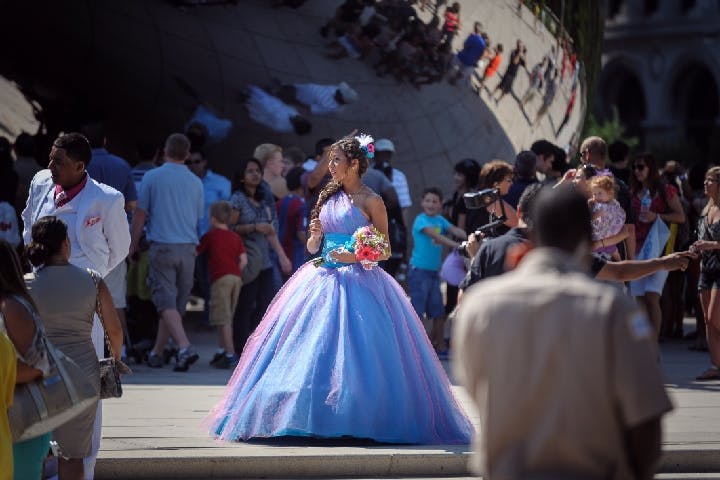Fall 2007
Crooked Tiara
– Jynelle Gracia
Reflections on the quinceanera, the Latina coming-of-age celebration.
Quinceañera, a prize-winner at last year’s Sundance Film Festival, stoked mainstream interest in the Latina coming-of-age celebration that served as the movie’s backdrop. In Once Upon a Quinceañera, Julia Alvarez examines this rite of passage more directly and finds it rife with contradictions. The quinceañera—the term refers both to the event and to the girl it celebrates—is frequently compared to a sweet sixteen party, but the analogy is limited. Celebrated on a girl’s 15th birthday, it usually includes a religious (typically Catholic) service, symbolic gifts, and plenty of pageantry. Traditionally, a court of 14 young couples represents the girl’s previous years of life and performs choreographed dances.
Variously celebrated throughout Latin America for centuries, the quinceañera once signaled a girl’s readiness for marriage. Now, what it marks is more ambiguous—particularly in the United States, where the event has become increasingly popular since it was imported when immigrants began heading north in large numbers in the 1960s.
Alvarez, a writer perhaps best known for her novel How the García Girls Lost Their Accents (1991), documents a quinceañera held in honor of a Queens, New York, girl named Monica, while weaving in memories of her own adolescence at a Massachusetts boarding school, visits with her family in the Dominican Republic, and her preoccupation with narratives and rituals that can empower women. She also visits Latino communities in Texas and California and on the East Coast, and interviews anyone who has a hand in putting on a quinceañera—event planners, priests, seamstresses, bakers, photographers, wise aunts and grandmothers.
The modern American incarnation of the quinceañera can be an outrageous production with a six-figure budget, themed cruises, and a profusion of anything pink and princesslike. Monica’s celebration, a catered reception at a modest venue, is closer to the norm. The girls in her court are dressed as Disney heroines—popular choices, especially Cinderella, for these occasions. (A Hummer limo replaces the pumpkin coach.) As with the wedding and bat mitzvah industries, websites, magazines, and vendor expos support these distinctly American quinceañera iterations.
Yet there’s a dark edge to all the frills and fun, says Alvarez, an “odd disparity between the fantasy the ritual enacts and the facts of these young girls’ lives.” A late-1990s study conducted by the organization now known as the National Alliance for Hispanic Health reported that Latinas in U.S. high schools have higher rates of teen pregnancy and attempted suicide, and lower graduation rates, than their peers.
Healthier alternatives to the extravagant blowouts do exist, Alvarez suggests, citing the primarily Mexican custom of welcoming madrinas and padrinos—friends and relatives who purchase the girl’s ball gown, pay the musicians’ fees, and so on. In this way, the entire community invests in the young celebrant. Yet the gifts the girl receives—including a ceremonial first pair of high-heeled shoes and last doll—send a “clear message”: “We expect you to get married, have children, devote yourself to your family.” That message might seem merely old-fashioned but for Alvarez’s reminders about these girls’ teen pregnancies and underrepresentation in higher education.
Alvarez is forthright about the book’s limitations. She’s conscious that the quinceañeras she interviews are just kids, who find her incessant questions a drag (“This is becoming annoying,” one girl complains). And she concedes that for all her earnest desire to revise the quinceañera, her guilty conscience whispers accusations of cultural betrayal.
Her internal struggle shows how difficult cultural change can be—and also reveals one of the book’s chief strengths: the author’s sensitivity and fierce compassion. When Monica is formally presented to her party guests, Alvarez rises and joins in the wild applause, “though I’ve seen the behind-the-scenes ropes and pulleys, often frayed or snapping, that are holding this moment in place.”
* * *
Reviewed: “Once Upon a Quinceanera: Coming of Age in the USA” by Julia Alvarez, Viking, 2007.
Photo courtesy of Flickr/kgnixer
